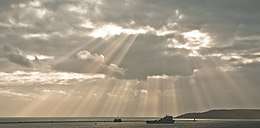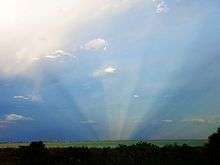Crepuscular rays

Crepuscular rays /krɪˈpʌskjʊlər/ (more commonly known as sunbeams, sun rays, splintered light, or god rays), in atmospheric optics, are rays of sunlight that appear to radiate from the point in the sky where the sun is located. These rays, which stream through openings in clouds (particularly stratocumulus) or between other objects, are columns of sunlit air particles separated by darker cloud-shadowed volumes. Despite seeming to converge toward the light source, the rays are in fact near-parallel shafts of sunlight. Their apparent convergence is a perspective effect. This phenomena mimics the way parallel railway lines or long hallways seem to seek convergence at a distant vanishing point. The sun rays do converge toward the sun, but the sun is much farther away than the rays might suggest.[2][3][4]
Some people, particularly flat-earthers who post videos on YouTube, argue that such an explanation is flawed since accompanying spots of light can be seen at the end of such crepuscular rays, shining on a lake, for example. They claim that they are, therefore, not produced by perspective. No credible institution or person currently supports this position, and no mathematical or empirical proofs have been provided by such people.
The name comes from their frequent occurrences during twilight hours (those around dawn and dusk), when the contrasts between light and dark are the most obvious. Crepuscular comes from the Latin word "crepusculum", meaning twilight.[5]
Anticrepuscular rays

The rays in some cases may extend across the sky and appear to converge at the antisolar point, the point on the sky sphere directly opposite the sun. In this case they are called anticrepuscular or antisolar rays.[6] These are not as easily spotted as crepuscular rays. This apparent dual convergence (to both the solar and antisolar points) is a perspective effect analogous to railway tracks appearing to converge to opposite points in opposite directions.[7]
Color
Crepuscular rays usually appear orange because the path through the atmosphere at sunrise and sunset passes through up to 40 times as much air as rays from a high midday sun. Particles in the air scatter short wavelength light (blue and green) through Rayleigh scattering much more strongly than longer wavelength yellow and red light.
Alternative names
- Backstays of the sun—a nautical term, from the fact that backstays that brace the mast of a sailing ship converge in a similar way
- Buddha rays
- Cloud breaks
- Jacob's Ladder
- Ropes of Maui—originally taura a Maui—from the Maori tale of Maui Potiki restraining the sun with ropes to make the days longer
- Shafts of light
- Sun drawing water—from the ancient Greek belief that sunbeams drew water into the sky (an early description of evaporation)
- Sunbeams
- Sunburst
- Volumetric lighting (used by the computer graphics industry)
- God rays (used by the computer graphics industry[8])
- Fingers of God
- Jesus rays
- Devil's rays (refers to anticrepuscular rays only)
- Tyndall rays
- God’s Eye
See also

References
- ↑ "Crepuscular Rays, India". Earth Observatory. NASA. Retrieved 2018-05-07.
- ↑ "Crepuscular Rays". Weather World 2010. University of Illinois, Champaign-Urbana.
- ↑ Schaefer, Vincent J.; Day, John A.; Pasachoff, Jay (1998). A Field Guide to the Atmosphere. Houghton Mifflin Harcourt. p. 169.
- ↑ "Crepuscular Rays, India". Earth Observatory. NASA. Retrieved 2018-05-07.
- ↑ Edens, Harald. "Crepuscular rays". Weather Photography lightning, clouds, atmospheric optics & astronomy. Retrieved November 1, 2011.
- ↑ Cowley, Les. "Anti-solar (anti-crepuscular) rays". Atmospheric Optics. Retrieved March 19, 2015.
- ↑ Day, John A. (2005). The Book of Clouds. Sterling. pp. 124–127. ISBN 978-1-4027-2813-6. Retrieved 2010-10-09.
- ↑ E.g. this term is mentioned in: Krüger, Jens; Bürger, Kai; Westermann, Rüdiger (2006). "Interactive screen-space accurate photon tracing on GPUs" (PDF). Proceedings of the 17th Eurographics conference on Rendering Techniques (EGSR'06).
External links
| Wikimedia Commons has media related to: |
